Experimental Study of Mechanical Properties and Theoretical Models for Recycled Fine and Coarse Aggregate Concrete with Steel Fibers
Abstract
:1. Introduction
2. Experimental Design
2.1. Materials
2.1.1. Shrinkage Performance Test
2.1.2. Uniaxial Compression Tests
2.2. Mix Proportion and Experimental Methodology
2.2.1. Shrinkage Performance Test
2.2.2. Uniaxial Compression Tests
3. Results and Discussion
3.1. Shrinkage Performance Analysis
3.1.1. Test Results and Analysis of Compressive Strength
3.1.2. Test Results and Analysis of Shrinkage
28 Day Shrinkage
Age-Shrinkage Curve
3.1.3. Empirical Model of Shrinkage
3.2. Constitutive Relationship under Uniaxial Compression
3.2.1. Failure Model
3.2.2. Stress-Strain Curve under Uniaxial Compression
3.2.3. Peak Stress and Peak Strain
- (1)
- Compared to regular concrete (VF0-R0), the peak stress decreases by 4.8%, 9.7%, and 23.7% when the replacement ratio of recycled fine aggregates is 30%, 50%, and 100%, respectively, In the case of steel fiber-reinforced concrete, the peak stress decreases by 3.0%, 7.2%, and 15.1% for replacement ratios of 30%, 50%, and 100% of recycled fine aggregates, respectively, compared to steel fiber-reinforced concrete (VF1.2-R0). As the replacement ratio of recycled fine aggregates increases, the peak strain exhibits an upward trend. This can be attributed to the presence of a considerable amount of cement mortar adhered to the surface of the recycled fine aggregates, which affects cement hydration and increases porosity. Additionally, the lower strength of recycled fine aggregates compared to natural sand leads to increased peak strain and decreased peak stress in recycled fine aggregate concrete. Moreover, the inclusion of steel fibers enables the strength of concrete with a replacement ratio of 100% (VF1.2-R100) to approach that of ordinary concrete VF0-R0 (45.50 MPa). This finding highlights the potential for higher replacement ratios of recycled fine aggregates when steel fibers are incorporated, thereby enhancing their application.
- (2)
- For steel fiber-reinforced recycled aggregate concrete, the peak stress increases by 8.9%, 15.8%, and 14.1%, respectively, when the volume fractions of steel fibers are 0.6%, 1.2%, and 1.8%, compared to ordinary recycled aggregate concrete without steel fibers (VF0-R50). Additionally, as the volume fraction of steel fibers increases, the peak strain significantly rises. This can be attributed to the steel fibers restraining the disintegration of cement mortar and suppressing crack development in the concrete, thereby reducing the scale of micro-cracks and creating a more continuous and uniform stress field [31]. Consequently, the compressive strength of recycled concrete slightly improves, while the peak strain greatly increases. However, it is essential to avoid excessive volume fractions of steel fibers, as it may lead to non-uniform distribution and clustering during the casting process, negatively affecting the workability and compressive strength of the concrete.
3.2.4. Elastic Modulus
3.2.5. Constitutive Model under Axial Compression
4. Conclusions
Author Contributions
Funding
Institutional Review Board Statement
Informed Consent Statement
Data Availability Statement
Acknowledgments
Conflicts of Interest
References
- Prasad, D.; Singh, B.; Suman, S.K. Utilization of recycled concrete aggregate in bituminous mixtures: A comprehensive review. Constr. Build. Mater. 2022, 326, 126859. [Google Scholar] [CrossRef]
- Eguchi, K.; Teranishi, K.; Nakagome, A.; Kishimoto, H.; Shinozaki, K.; Narikawa, M. Application of recycled coarse aggregate by mixture to concrete construction. Constr. Build. Mater. 2007, 21, 1542–1551. [Google Scholar] [CrossRef]
- Wang, H.Y.; Hsiao, D.H.; Wang, S.Y. Properties of recycled green building materials applied in lightweight aggregate concrete. Comput. Concr. 2012, 10, 95–104. [Google Scholar] [CrossRef]
- Qin, X.; Kaewunruen, S. Environment-friendly recycled steel fiber reinforced concrete. Constr. Build. Mater. 2022, 327, 126967. [Google Scholar] [CrossRef]
- Revilla-Cuesta, V.; Evangelista, L.; de Brito, J.; Skaf, M.; Manso, J.M. Shrinkage prediction of recycled aggregate structural concrete with alternative binders through partial correction coefficients. Cem. Concr. Compos. 2022, 129, 104506. [Google Scholar] [CrossRef]
- Cantero, B.; Bravo, M.; De Brito, J.; Del Bosque, I.S.; Medina, C. Water transport and shrinkage in concrete made with ground recycled concrete-additioned cement and mixed recycled aggregate. Cem. Concr. Compos. 2021, 118, 103957. [Google Scholar] [CrossRef]
- Gonzalez-Corominas, A.; Etxeberria, M. Effects of using recycled concrete aggregates on the shrinkage of high performance concrete. Constr. Build. Mater. 2016, 115, 32–41. [Google Scholar] [CrossRef]
- Zhang, X.; Kuang, C.; Fang, Z.; Liu, X. Orthogonal Experimental Study on Strength of Steel Fiber Reinforced Fly Ash Recycled Concrete. J. Build. Mater. 2014, 17, 677–684+694. [Google Scholar]
- Kayali, O.; Haque, M.N.; Zhu, B. Drying shrinkage of fibre-reinforced lightweight aggregate concrete containing fly ash. Cem. Concr. Res. 1999, 29, 1835–1840. [Google Scholar] [CrossRef]
- Grzegorz, L.G. Effect of Coarse Aggregate Grading on Mechanical Parameters and Fracture Toughness of Limestone Concrete. Infrastructures 2023, 8, 117. [Google Scholar] [CrossRef]
- Luo, H.; Aguiar, J.; Wan, X.; Wang, Y.; Cunha, S.; Jia, Z. Application of Aggregates from Construction and Demolition Wastes in Concrete: Review. Sustainability 2024, 16, 4277. [Google Scholar] [CrossRef]
- Gayarre, F.L.; Perez, C.L.C.; Lopez, M.A.S.; Cabo, A.D. The effect of curing conditions on the compressive strength of recycled aggregate concrete. Constr. Build. Mater. 2014, 53, 260–266. [Google Scholar] [CrossRef]
- Sunayana, S.; Barai, S.V. Partially fly ash incorporated recycled coarse aggregate based concrete: Microstructure perspectives and critical analysis. Constr. Build. Mater. 2021, 5, 1–23. [Google Scholar] [CrossRef]
- Tam, V.W.; Mirza, O.; Senaratne, S.; Kang, W.H.; Kotrayothar, D. Shrinkage development of recycled aggregate concrete and future directions of using steel fibers as a reliable and cost-effective option. Dis. Aquat. Org. 2013, 101, 217–223. [Google Scholar]
- Wu, Q.Q.; Xiao, Z.L.; Li, D. Experimental Study on Mechanical and Shrinkage Properties of Steel Fiber Reinforced Recycled Concrete. Hunan Transp. Sci. Technol. 2020, 46, 45–48. (In Chinese) [Google Scholar]
- Folino, P.; Xargay, H. Recycled aggregate concrete—Mechanical behavior under uniaxial and triaxial compression. Constr. Build. Mater. 2014, 56, 21–31. [Google Scholar] [CrossRef]
- Gao, D.; Zhu, Q.; Liu, J. Constitutive model of SFRCAC under uniaxial compression. J. Basic Sci. Eng. 2020, 28, 396–406. [Google Scholar]
- Xiao, L.; Ying, D. Durability of Recycled Aggregate Concrete: An Overview. J. Adv. Concr. Technol. 2013, 11, 347–359. [Google Scholar] [CrossRef]
- Bamigboye, G.O.; Ademola, D.; Kareem, M.; Orogbade, B.; Odetoyan, A.; Adeniyi, A. Durability assessment of recycled aggregate in concrete production. In The Structural Integrity of Recycled Aggregate Concrete Produced with Fillers and Pozzolans; Woodhead Publishing: Sawston, UK, 2022; Volume 1, pp. 445–467. [Google Scholar]
- JGJ 52-2006; Quality Standard and Testing Method for Crushed Stone or Gravel for Ordinary Concrete. Ministry of Construction of the PRC: Beijing, China, 2006.
- Gao, D.; Zhang, L.; Nokken, M. Compressive behavior of steel fiber reinforced recycled coarse aggregate concrete designed with equivalent cubic compressive strength. Constr. Build. Mater. 2017, 141, 235–244. [Google Scholar] [CrossRef]
- GB/T 50082-2009; Standard Test Methods for Long-Term Performance and Durability of Ordinary Concrete. China Architecture & Building Press: Beijing, China, 2009.
- GB/T 50081-2019; Standards for Test Methods of Physical and Mechanical Properties of Concrete. General Administration of Quality Supervision, Inspection and Quarantine of China: Shenzhen, China, 2019.
- G/T240-2011; Technical Specification for Application of Recycled Aggregate. Ministry of Housing and Urban Rural Development of the People’s Republic of China: Beijing, China, 2011.
- CECS 13-2009; Standard for Test Methods of Fiber Reinforced Concrete. Industrial Standards of the People’s Republic of China: Beijing, China, 2009.
- Domingo-Cabo, A.; Lázaro, C.; López-Gayarre, F.; Serrano-López, M.A.; Serna, P.; Castaño-Tabares, J.O. Creep and shrinkage of recycled aggregate concrete. Constr. Build. Mater. 2009, 23, 2545–2553. [Google Scholar] [CrossRef]
- Xiao, Z.; Xu, X.D.; Fan, Y.H. Experimental Study on Shrinkage Creep of Recycled Concrete and Creep Neural Network Prediction. J. Build. Mater. 2013, 16, 752–757. (In Chinese) [Google Scholar]
- Cui, Z.L.; Hao, L.; Chen, L.; Lan, Y. Influence of Curing Environment and Replacement Rate on Drying Shrinkage Cracks of Recycled Concrete. Bull. Chin. Ceram. Soc. 2015, 34, 3267–3270. (In Chinese) [Google Scholar]
- Jafarifar, N.; Pilakoutas, K.; Bennett, T. Moisture transport and drying shrinkage properties of steel fibre reinforced concrete. Constr. Build. Mater. 2014, 73, 41–50. [Google Scholar] [CrossRef]
- Wu, L.M.; Shi, C.; Zhang, Z.; Wang, H. Effects of Steel Fiber on Drying Shrinkage of Ultra-High Performance Concrete. Mater. Rev. 2017, 31, 58–65. (In Chinese) [Google Scholar]
- Gao, D.; Li, W.; Pang, Y.; Huang, Y. Behavior analysis and strength prediction of steel fiber reinforced recycled aggregate concrete column under axial compression. Constr. Build. Mater. 2021, 290, 123278. [Google Scholar] [CrossRef]
- Xingwen, L. Design Principle of Concrete Structure, 2nd ed.; China Construction Industry Press: Beijing, China, 2011. (In Chinese) [Google Scholar]
- Zhenhai, G. Strength and Deformation of Concrete—Test Foundation and Constitutive Relationship; Tsinghua University Press: Beijing, China, 1997. (In Chinese) [Google Scholar]
- Yishuai, T.; Youkai, P.; Hui, W. Constitutive relationship of recycled concrete with different recycled fine aggregate replacement rates under uniaxial compression. Concrete 2019, 3, 65–70. [Google Scholar]
- Shusen, Y. Experimental Study on Mechanical Properties of Fiber Recycled Fine Aggregate Concrete and Seismic Performance of Precast Composite Wall. Ph.D. Thesis, Xi’an University of Architecture and Technology, Xi’an, China, 2017. (In Chinese). [Google Scholar]
- Hrabová, K.; Láník, J.; Lehner, P. Statistical and Practical Evaluation of the Mechanical and Fracture Properties of Steel Fibre Reinforced Concrete. Buildings 2022, 12, 1082. [Google Scholar] [CrossRef]
- Lehner, P.; Horňáková, M. Effect of amount of fibre and damage level on service life of SFR recycled concrete in aggressive Environment. Buildings 2021, 11, 489. [Google Scholar] [CrossRef]

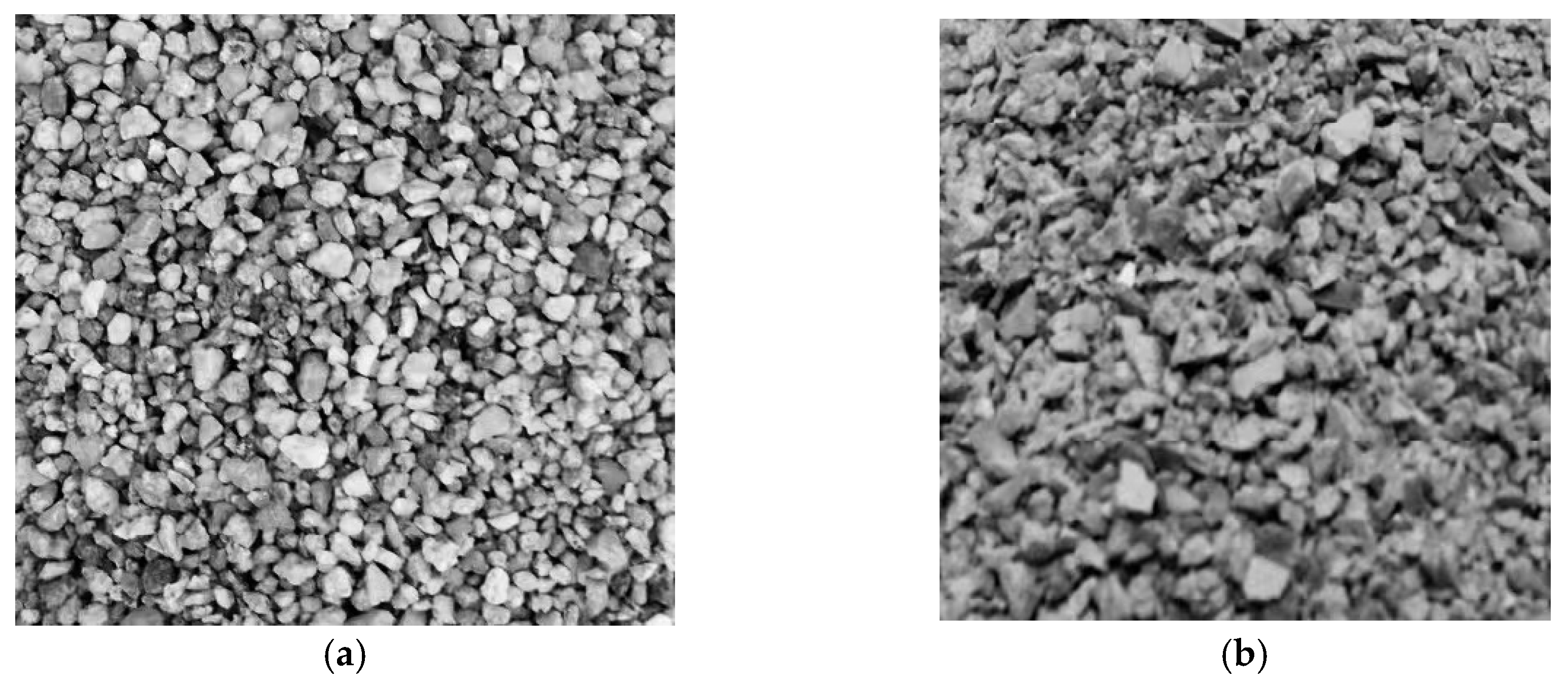
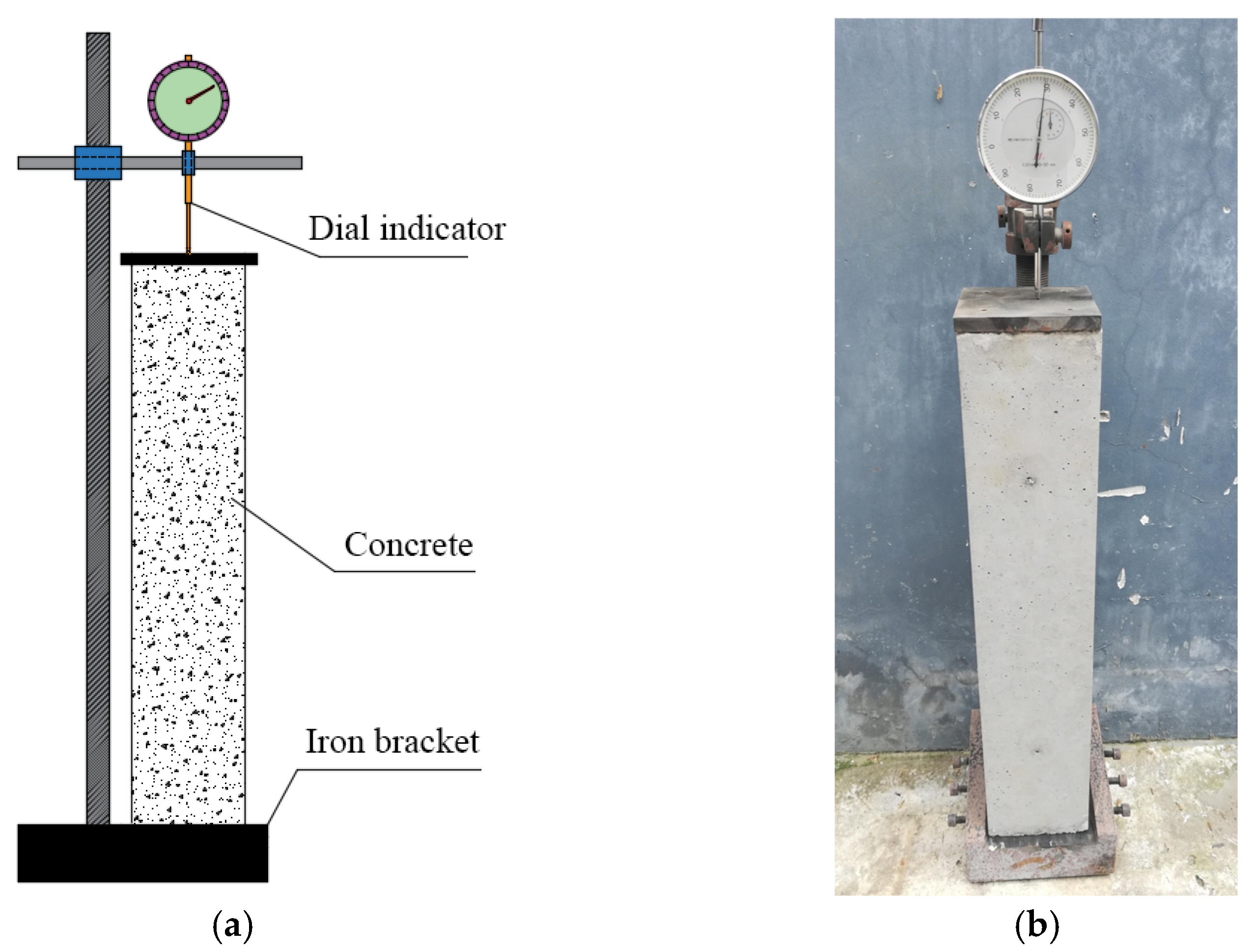
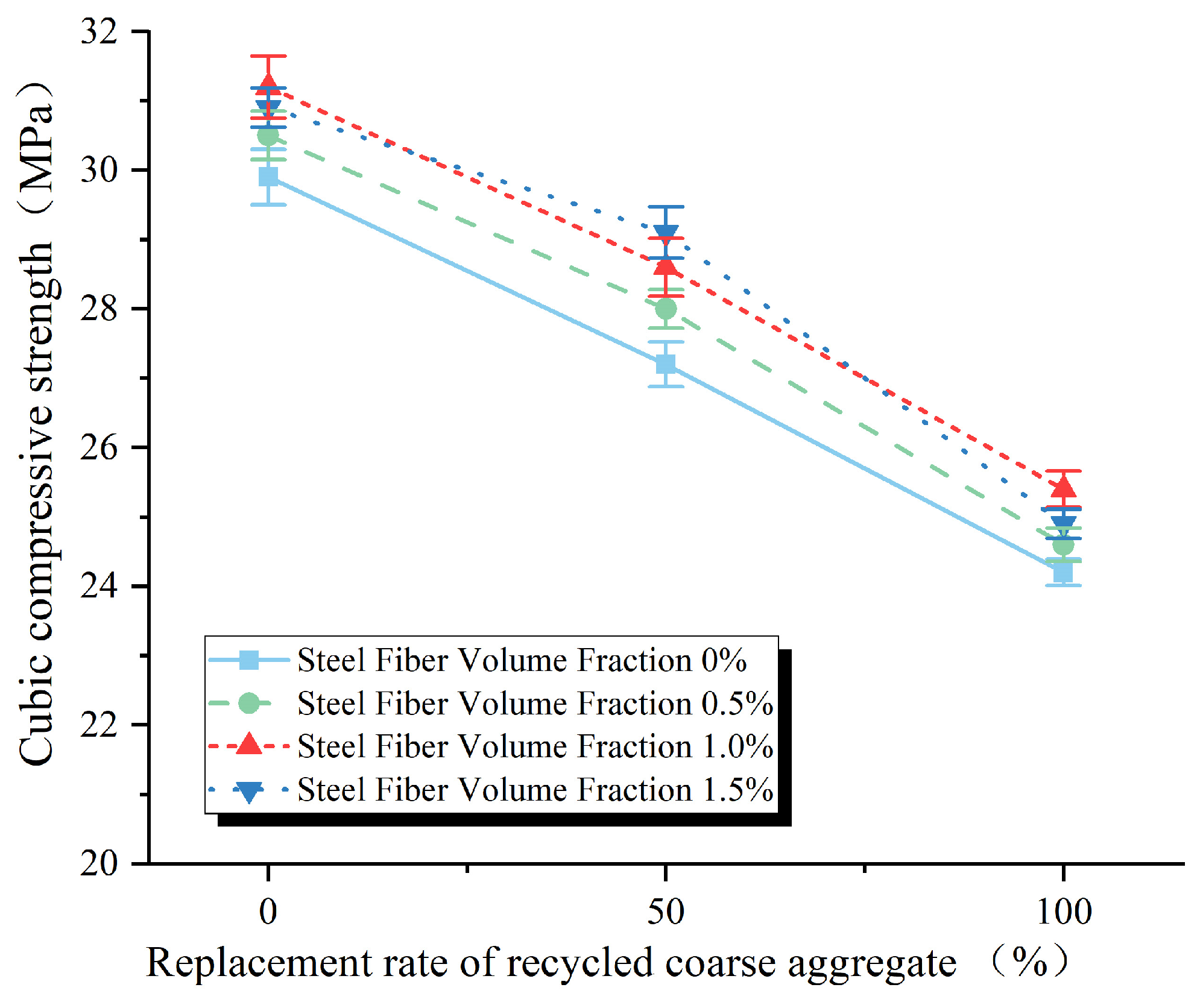
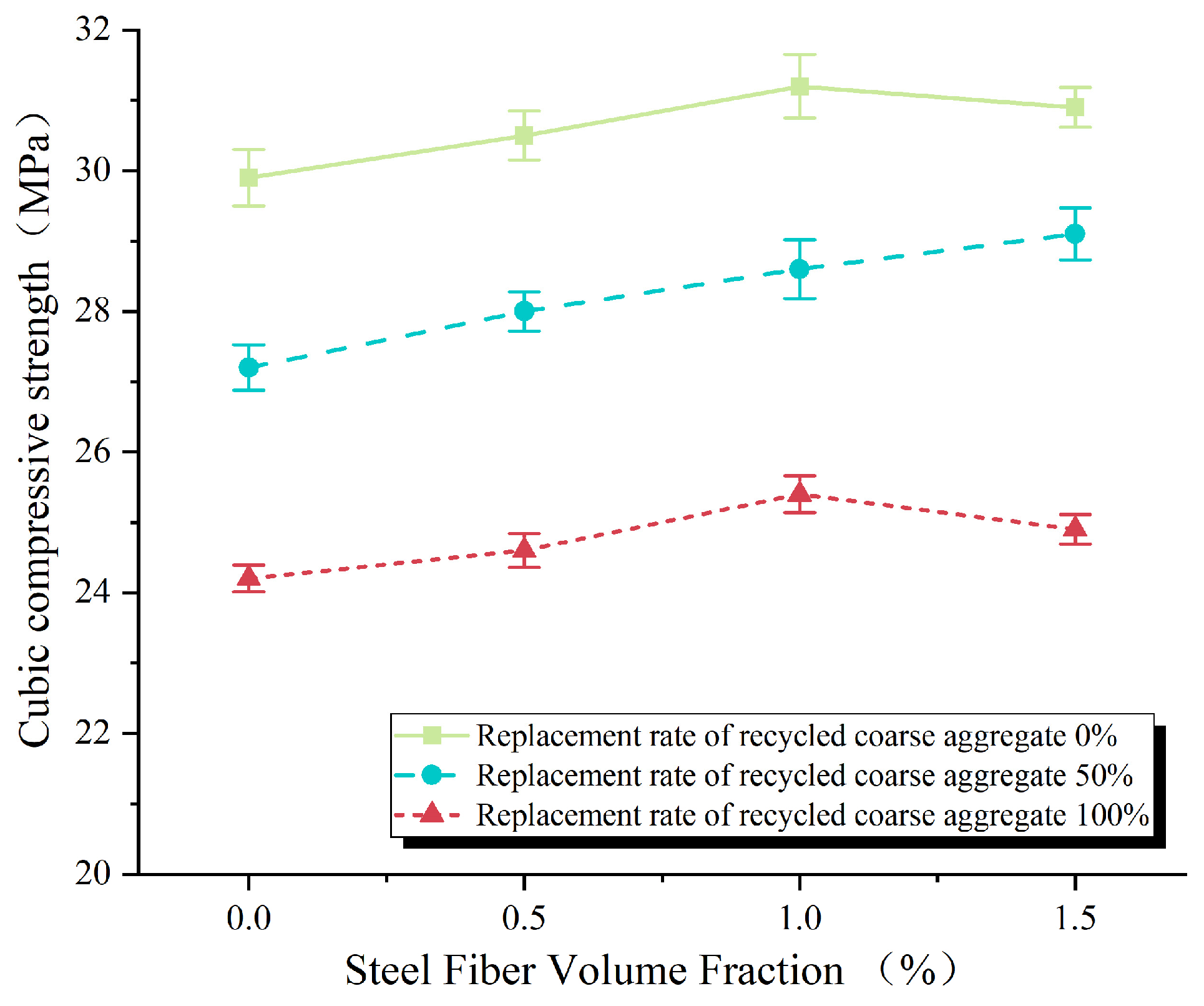
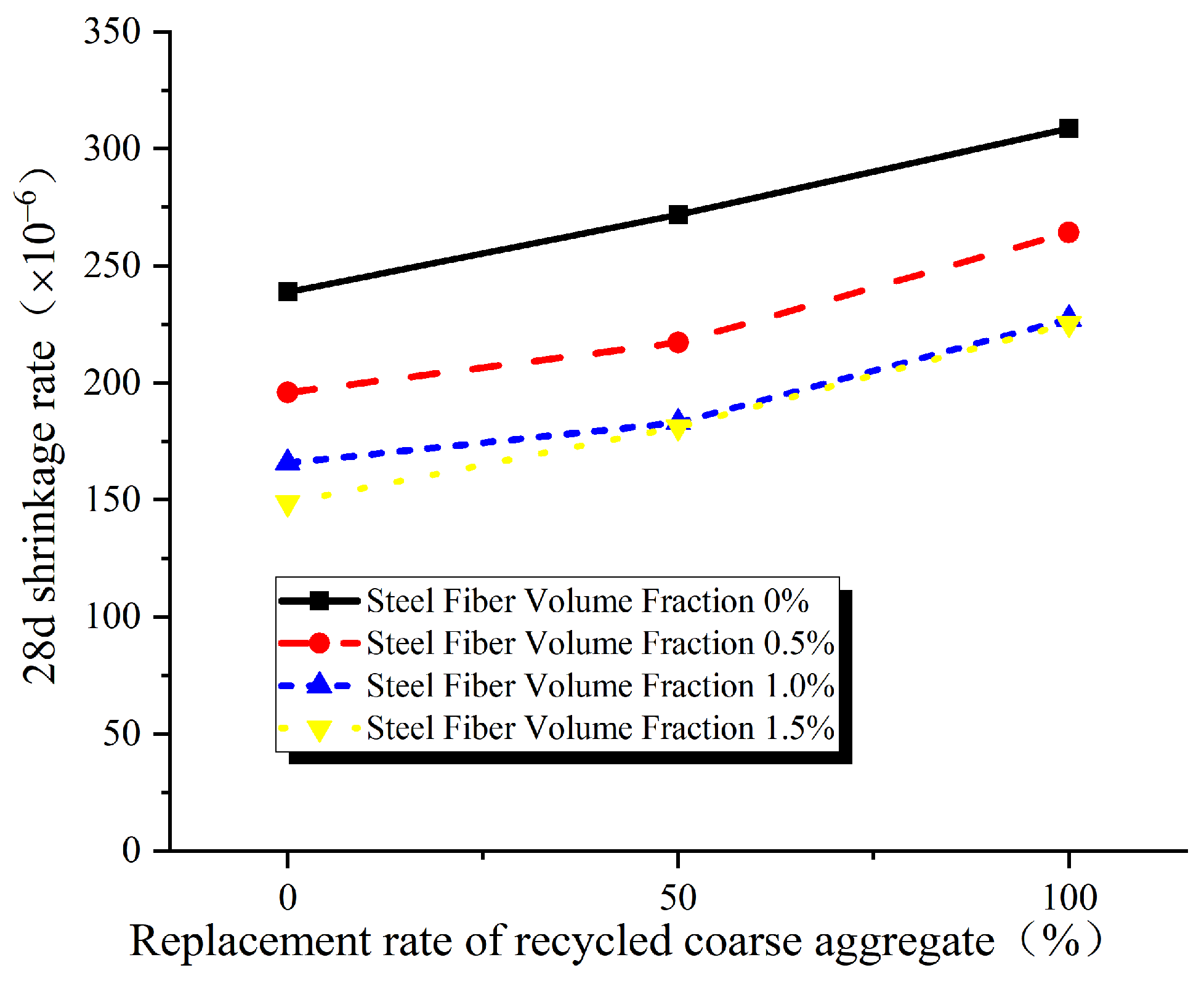


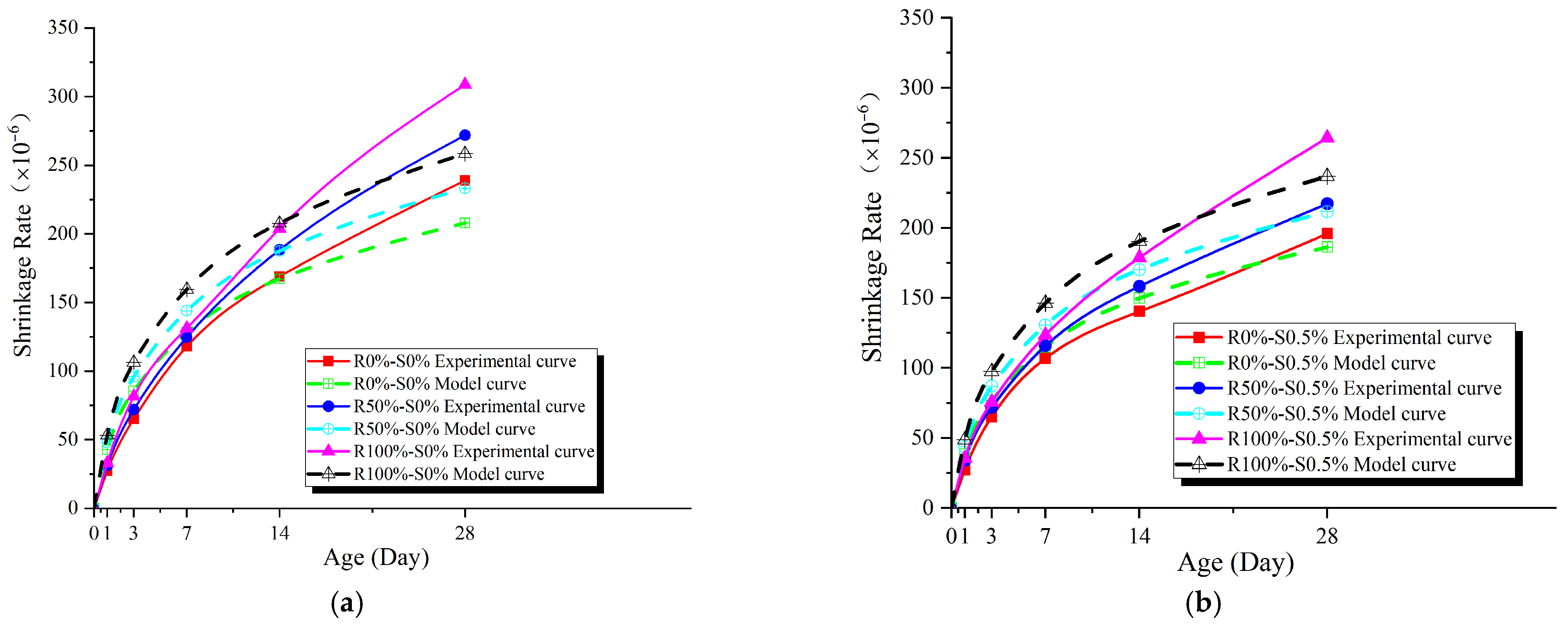
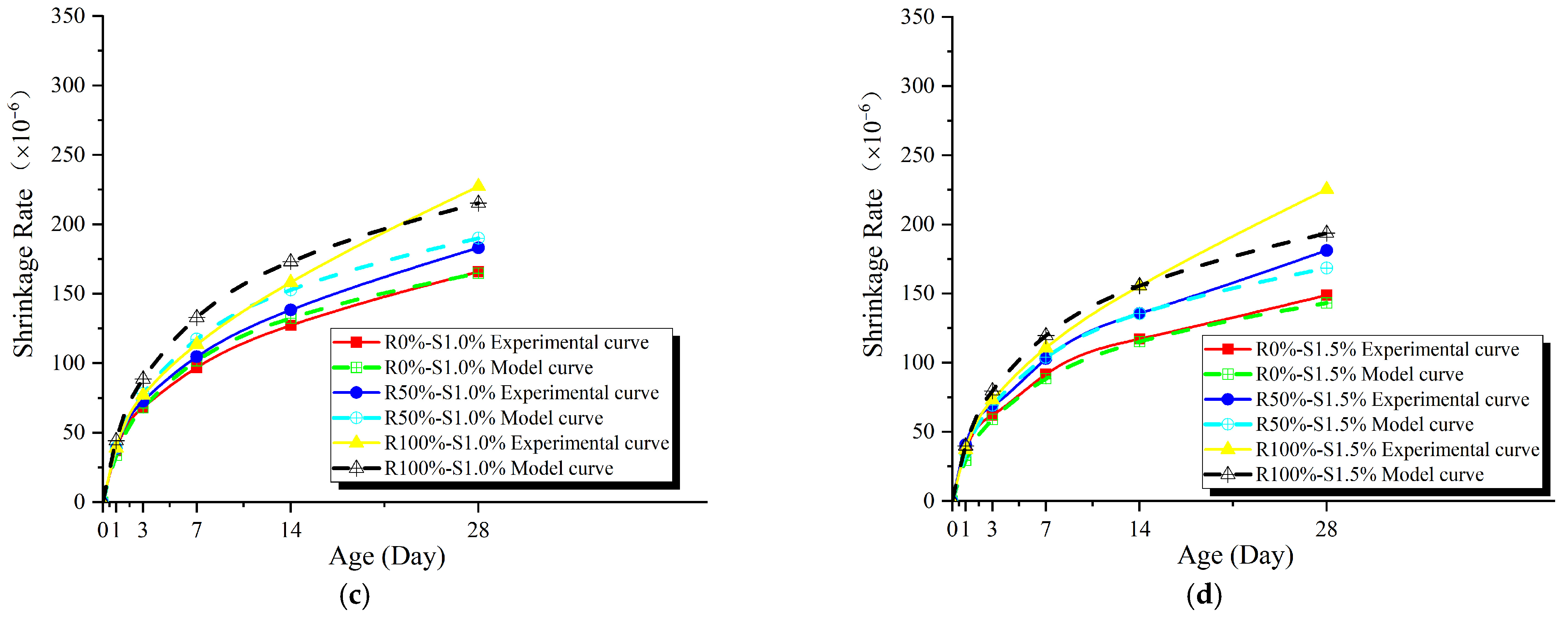
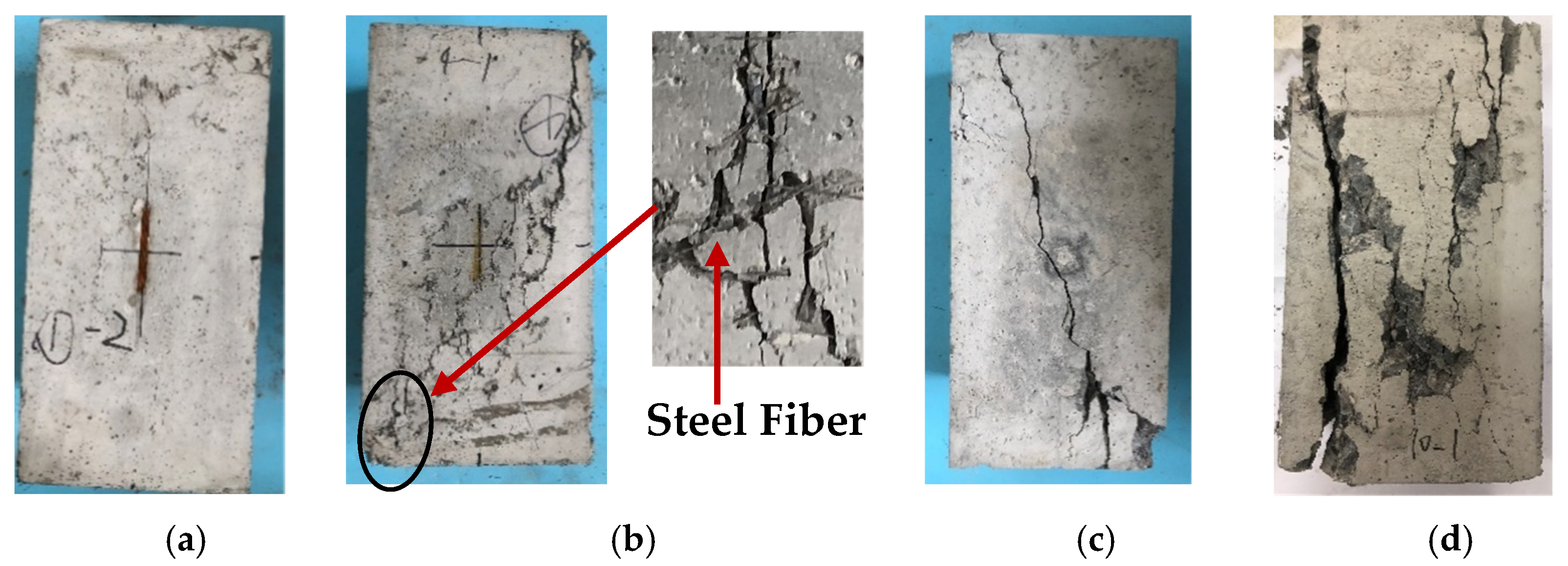

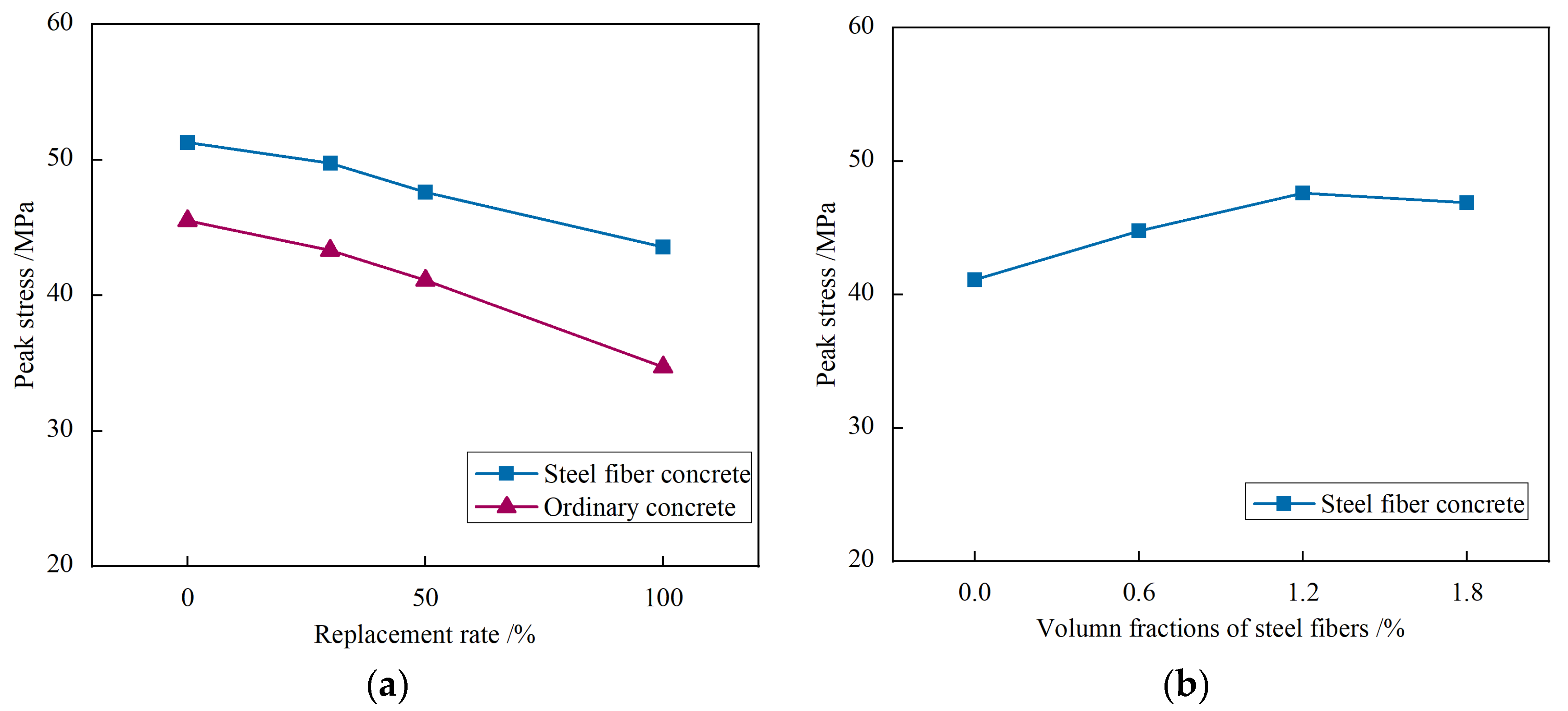


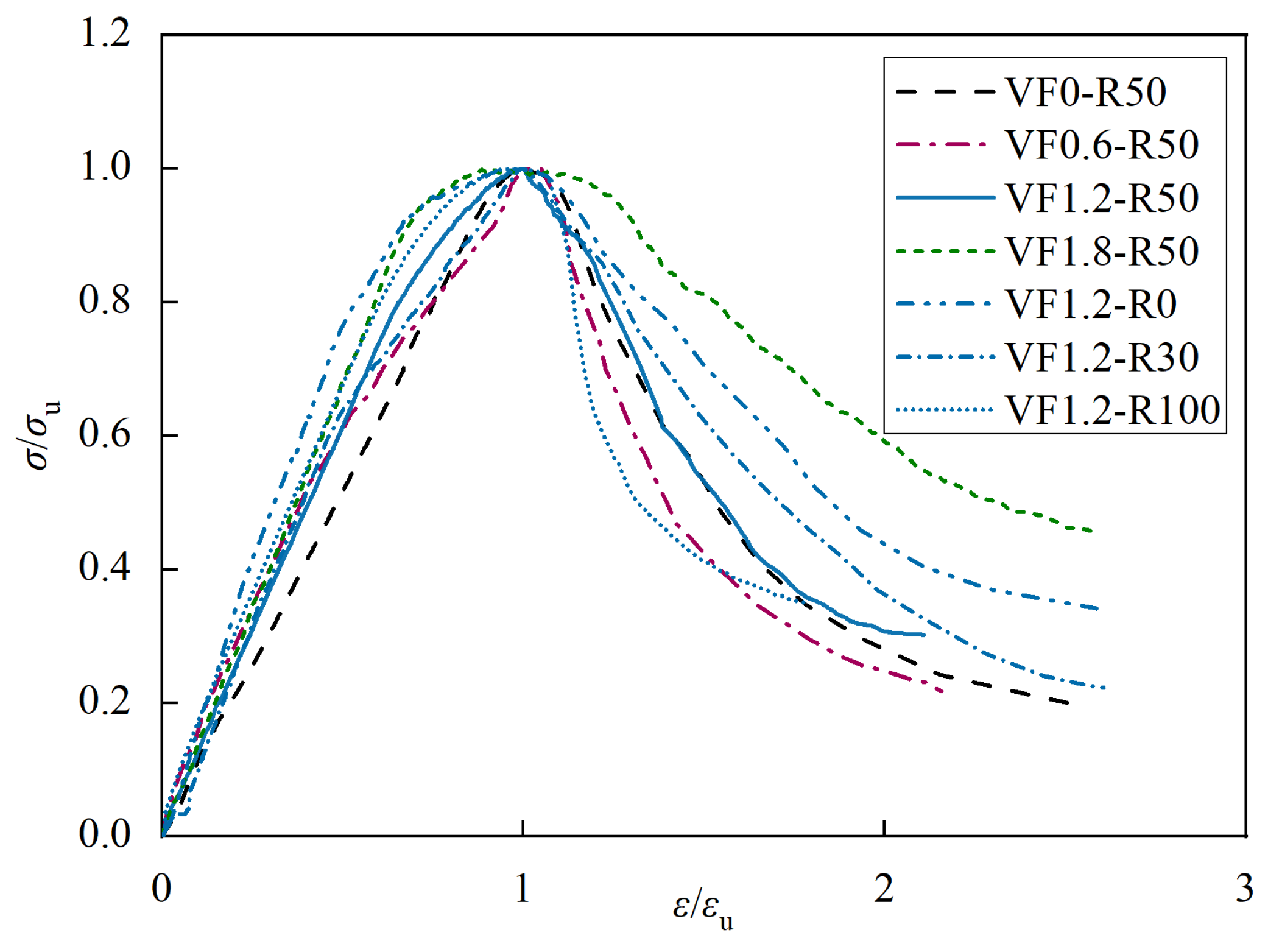


| Aggregate Types | Apparent Density/(kg/m3) | Bulk Density/(kg/m3) | Crushing Value/% | Water Absorption Rate/% |
|---|---|---|---|---|
| Natural coarse aggregate | 2710 | 1735 | 4.5 | 0.42 |
| Natural fine aggregate | 2683 | 1412 | 13.2 | 2.23 |
| Recycled fine aggregate | 2786 | 1470 | 15.4 | 5.30 |
| Number | Cement | River Sand | Coarse Aggregate | Water | Steel Fiber | Water Reducer | |
|---|---|---|---|---|---|---|---|
| Natural | Recycled | ||||||
| R0%-S0% | 260 | 750 | 1220 | 0 | 170 | 0 | 0 |
| R0%-S0.5% | 260 | 750 | 1220 | 0 | 170 | 39.3 | 2.51 |
| R0%-S1.0% | 260 | 750 | 1220 | 0 | 170 | 78.5 | 4.32 |
| R0%-S1.5% | 260 | 750 | 1220 | 0 | 170 | 117.8 | 6.15 |
| R50%-S0% | 260 | 750 | 610 | 610 | 182 | 0 | 0 |
| R50%-S0.5% | 260 | 750 | 610 | 610 | 182 | 39.3 | 2.51 |
| R50%-S1.0% | 260 | 750 | 610 | 610 | 182 | 78.5 | 4.32 |
| R50%-S1.5% | 260 | 750 | 610 | 610 | 182 | 117.8 | 6.15 |
| R100%-S0% | 260 | 750 | 0 | 1220 | 194 | 0 | 0 |
| R100%-S0.5% | 260 | 750 | 0 | 1220 | 194 | 39.3 | 2.51 |
| R100%-S1.0% | 260 | 750 | 0 | 1220 | 194 | 78.5 | 4.32 |
| R100%-S1.5% | 260 | 750 | 0 | 1220 | 194 | 117.8 | 6.15 |
| Number | Rate of Recycled Concrete /% | Volume Fraction of Steel Fibers/% | Cement /(kg/m3) | Coarse Aggregate /(kg/m3) | Natural Fine Aggregate /(kg/m3) | Recycled Fine Aggregate /(kg/m3) | Water /(kg/m3) | Fly Ash /(kg/m3) | Steel Fibers /(kg/m3) | Water Reducer /(kg/m3) |
|---|---|---|---|---|---|---|---|---|---|---|
| VF1.2-R0 | 0 | 1.2 | 382 | 810 | 436 | 0 | 196 | 164 | 93.6 | 1.9 |
| VF1.2-R30 | 30 | 1.2 | 382 | 810 | 305 | 131 | 196 | 164 | 93.6 | 1.9 |
| VF1.2-R50 | 50 | 1.2 | 382 | 810 | 218 | 218 | 196 | 164 | 93.6 | 1.9 |
| VF1.2-R100 | 100 | 1.2 | 382 | 810 | 0 | 436 | 196 | 164 | 93.6 | 1.9 |
| VF0-R50 | 50 | 0 | 382 | 810 | 218 | 218 | 196 | 164 | 0 | 1.9 |
| VF0.6-R50 | 50 | 0.6 | 382 | 810 | 218 | 218 | 196 | 164 | 46.8 | 1.9 |
| VF1.8-R50 | 50 | 1.8 | 382 | 810 | 218 | 218 | 196 | 164 | 140.4 | 1.9 |
| VF0-R0 | 0 | 0 | 382 | 810 | 436 | 0 | 196 | 164 | 0 | 1.9 |
| VF0-R30 | 30 | 0 | 382 | 810 | 305 | 131 | 196 | 164 | 0 | 1.9 |
| VF0-R100 | 100 | 0 | 382 | 810 | 0 | 436 | 196 | 164 | 0 | 1.9 |
| Number | fcu (MPa) | Number | fcu (MPa) | Number | fcu (MPa) |
|---|---|---|---|---|---|
| R0%-S0% | 29.9 | R50%-S0% | 27.2 | R100%-S0% | 24.2 |
| R0%-S0.5% | 30.5 | R50%-S0.5% | 28.0 | R100%-S0.5% | 24.6 |
| R0%-S1.0% | 31.2 | R50%-S1.0% | 28.6 | R100%-S1.0% | 25.4 |
| R0%-S1.5% | 30.9 | R50%-S1.5% | 29.1 | R100%-S1.5% | 24.9 |
| Number | Shrinkage Rate at Different Ages/×10−6 | ||||
|---|---|---|---|---|---|
| 1 Day | 3 Day | 7 Day | 14 Day | 28 Day | |
| R0%-S0% | 27.2 | 65.2 | 118 | 169 | 238.9 |
| R0%-S0.5% | 27.2 | 65.2 | 107 | 140.3 | 195.9 |
| R0%-S1.0% | 37.2 | 68.2 | 97 | 127.3 | 165.9 |
| R0%-S1.5% | 36.2 | 62.2 | 91.8 | 117.3 | 148.9 |
| R50%-S0% | 31.1 | 71.9 | 124.7 | 188.4 | 271.9 |
| R50%-S0.5% | 34 | 71.8 | 115.8 | 158.3 | 217.3 |
| R50%-S1.0% | 38.5 | 72.7 | 104.7 | 138.4 | 183.1 |
| R50%-S1.5% | 40.8 | 68.8 | 102.9 | 135.7 | 181.2 |
| R100%-S0% | 33 | 81.5 | 131.2 | 203.8 | 308.7 |
| R100%-S0.5% | 35.5 | 75.7 | 123.4 | 178.8 | 264.3 |
| R100%-S1.0% | 39.1 | 77.1 | 113.6 | 158.3 | 227.4 |
| R100%-S1.5% | 37.2 | 73.2 | 110.8 | 155.5 | 225.4 |
| Number | Coefficient β | Error | R2 |
|---|---|---|---|
| R0%-S0% | 63.65407 | ±3.592 | 0.95988 |
| R0%-S0.5% | 53.99255 | ±1.901 | 0.9828 |
| R0%-S1.0% | 48.24704 | ±0.627 | 0.99726 |
| R0%-S1.5% | 44.14647 | ±0.543 | 0.99747 |
| R50%-S0% | 71.11829 | ±4.568 | 0.94925 |
| R50%-S0.5% | 60.01522 | ±2.019 | 0.98409 |
| R50%-S1.0% | 52.62441 | ±0.785 | 0.99649 |
| R50%-S1.5% | 51.78516 | ±0.984 | 0.99428 |
| R100%-S0% | 78.74716 | ±5.802 | 0.93519 |
| R100%-S0.5% | 69.30818 | ±4.005 | 0.95711 |
| Number | Fine Aggregate Rate/% | Volume Fraction of Steel Fibers/% | Peak Stress/MPa | Variance | Elastic Modulus/GPa | Variance | Peak Strain/με | Variance |
|---|---|---|---|---|---|---|---|---|
| VF1.2-R0 | 0 | 1.2 | 51.29 | 2.02 | 33.44 | 2.75 | 1999 | 9986 |
| VF1.2-R30 | 30 | 1.2 | 49.76 | 8.74 | 30.59 | 6.78 | 2119 | 4981 |
| VF1.2-R50 | 50 | 1.2 | 47.61 | 5.34 | 26.68 | 11.20 | 2162 | 6626 |
| VF1.2-R100 | 100 | 1.2 | 43.56 | 4.18 | 23.85 | 5.52 | 2278 | 5643 |
| VF0-R50 | 50 | 0 | 41.11 | 14.56 | 24.86 | 5.09 | 1743 | 5766 |
| VF0.6-R50 | 50 | 0.6 | 44.77 | 6.55 | 24.32 | 3.44 | 2050 | 3915 |
| VF1.8-R50 | 50 | 1.8 | 46.89 | 13.02 | 27.76 | 6.86 | 2165 | 6144 |
| VF0-R0 | 0 | 0 | 45.50 | 15.65 | 31.21 | 3.30 | 1657 | 5013 |
| VF0-R30 | 30 | 0 | 43.33 | 9.68 | 27.39 | 4.62 | 1681 | 2251 |
| VF0-R100 | 100 | 0 | 34.71 | 8.40 | 21.59 | 2.28 | 1875 | 4817 |
| Number | Parameter a | Calculated Value | Experiment/ Calculation | Correlation Coefficient R2 | Parameter b | Calculated Value | Experiment/ Calculation | Correlation Coefficient R2 |
|---|---|---|---|---|---|---|---|---|
| VF1.2-R0 | 1.84 | 1.86 | 0.99 | 0.9964 | 2.45 | 2.20 | 1.11 | 0.9914 |
| VF1.2-R30 | 1.12 | 1.12 | 1.00 | 0.9899 | 3.61 | 3.30 | 1.09 | 0.9959 |
| VF1.2-R50 | 1.00 | 0.93 | 1.08 | 0.9984 | 5.22 | 4.04 | 1.29 | 0.9938 |
| VF1.2-R100 | 1.49 | 1.51 | 0.99 | 0.9977 | 7.60 | 6.87 | 1.29 | 0.8872 |
| VF0-R50 | 0.37 | 0.47 | 0.79 | 0.9703 | 5.45 | 7.55 | 0.72 | 0.9960 |
| VF0.6-R50 | 0.79 | 0.70 | 1.13 | 0.9667 | 6.00 | 5.97 | 1.04 | 0.9830 |
| VF1.8-R50 | 1.40 | 1.16 | 1.21 | 0.9925 | 1.76 | 2.28 | 0.77 | 0.9965 |
| VF0-R0 | 1.86 | 1.86 | 1.00 | 0.9711 | 4.74 | 4.19 | 1.13 | 0.8320 |
| VF0-R30 | 0.93 | 0.82 | 1.13 | 0.9843 | 5.78 | 6.21 | 0.93 | 0.9447 |
| VF0-R100 | 0.79 | 0.78 | 1.01 | 0.9979 | 10.81 | 10.91 | 0.99 | 0.9754 |
Disclaimer/Publisher’s Note: The statements, opinions and data contained in all publications are solely those of the individual author(s) and contributor(s) and not of MDPI and/or the editor(s). MDPI and/or the editor(s) disclaim responsibility for any injury to people or property resulting from any ideas, methods, instructions or products referred to in the content. |
© 2024 by the authors. Licensee MDPI, Basel, Switzerland. This article is an open access article distributed under the terms and conditions of the Creative Commons Attribution (CC BY) license (https://creativecommons.org/licenses/by/4.0/).
Share and Cite
Wu, C.; Shi, Y.; Xu, J.; Luo, M.; Lu, Y.; Zhu, D. Experimental Study of Mechanical Properties and Theoretical Models for Recycled Fine and Coarse Aggregate Concrete with Steel Fibers. Materials 2024, 17, 2933. https://doi.org/10.3390/ma17122933
Wu C, Shi Y, Xu J, Luo M, Lu Y, Zhu D. Experimental Study of Mechanical Properties and Theoretical Models for Recycled Fine and Coarse Aggregate Concrete with Steel Fibers. Materials. 2024; 17(12):2933. https://doi.org/10.3390/ma17122933
Chicago/Turabian StyleWu, Cai, Yan Shi, Jiale Xu, Mingxing Luo, Yani Lu, and Daopei Zhu. 2024. "Experimental Study of Mechanical Properties and Theoretical Models for Recycled Fine and Coarse Aggregate Concrete with Steel Fibers" Materials 17, no. 12: 2933. https://doi.org/10.3390/ma17122933





